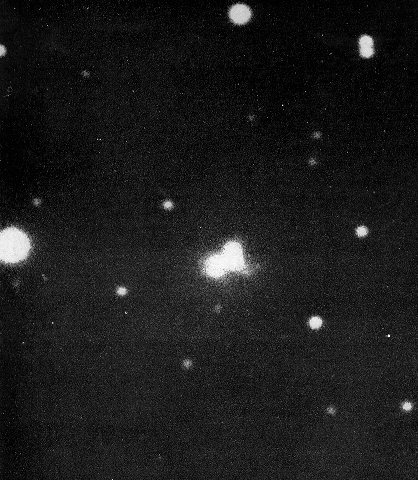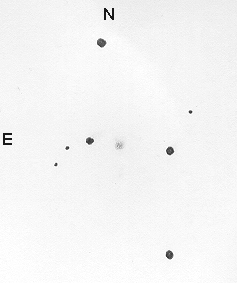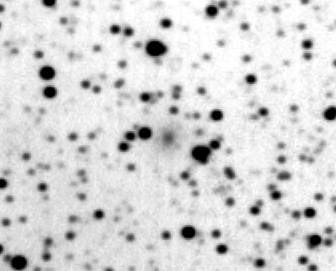
Cygnus A - Observing an Exceptional Radio Galaxy
Wolfgang Steinicke
After the 2nd World War an intensiv search for discrete radiosources was started. Obviously the brightest sources were found first. The designation was quite simple: constellation plus intensity, were "A" was the brightest, followed by "B" for the second brightest. Examples are Sagittarius A (center of our galaxy), Cassiopeia A (supernova remnant; 1680?), Centaurus A (active galaxy NGC 5128) and just Cygnus A. Unfortunately the first positions were pretty rough, which changes when using radiointerferometric methods, yielding an arcsecond accuracy. This made it possible to optically identify some sources in the early 50th. Among the first identifications was Cygnus A.
Discovery and physical nature
In 1944 Grote Reber discovered the radio source in Cygnus; it is the second strongest in the sky (after Cassiopeia A). Two years later, Hey, Parsons und Phillips revealed that Cygnus A shows short time flux changes, which points to a small angular diameter. Their first rough position (Cygnus A is located 5° west of Gamma Cygni) could be considerably improved in August 1951 by Graham Smith, using the new Cambridge interferometer. The Cambridge astronomer David Dewhirst (who sadly died in 2012), happy to have a copy of a Mt. Wilson photograph showing the field, was the first to identify the source as a faint globular nebulosity of 16.5 mag and 20" diameter with a central condensation [1]. Smith had sent the data via airmail to Walter Baade at Palomar Observatory and in September 1951 he confirmed the unusual object on a 200-inch plate [1a]. Baade was sure to see a collision of two galaxies (Fig. 1). He bet his skeptical colleague Rudolph Minkowski a 1000 US $! Minkowski believed the object to be a galactic "radio star". Finally they agreed on a bottle of whisky, which Baade won after Minkowski has taken a spectrum showing typical emission lines. The extragalactic nature followed from the measured redshift of z=0.056, corresponding to a radial velocity of 16,830 km/s. Cygnus A therfore is at a distance of 790 Mill. Lj.

Fig. 1 - First image of Cygnus A by Walter Baade with the 200" Hale reflector.
The galactic absorption is low near Gamma Cygni and so many galaxies shine through the „zone of avoidance". Already Baade realized, that Cygnus A is the dominant galaxy in a rich cluster, counting nearly 200 possible members. This type was later defined by Rood and Sastry as cD, meaning "core dominant". These are extreme luminous elliptical galaxies, often cannibals, showing extensive jets, emitted by their central massive black holes; examples are M 87 in the Virgo-Cluster or NGC 6166 in Abell 2199. Also Cygnus A has two radio jets, ending in huge lobes [2], [3] with an angular extension of 120", which is 400.000 Lj. By the way, there are amateur radio observations of the object: Bräutigam and Kauf has detected the source with their 3 m-radio telescope at the Starkenburg Observatory, Heppenheim (Germany) [4].
Baade's interpretation of a galactic collision war later rejected, he has got the bottle unjustly. In the modern picture the object is an elliptical galaxy with a huge central dust lane - a massive version of Centaurus A (further examples were given by Bertola [5]). Cygnus A hosts an active quasar core with Seyfert 1-spectrum [6], hidden behind the giant "doughnut"-formed dust ring [7]. The galaxy seams to be 1000 times more massive that our Milky Way (data in Tab. 1).
Visual observations

Abb. 2 - Drawing of Cygnus A by the author, made 1984 at a C-14 (power 450).
It took nearly 17 years for a second observation at the "Internationional Telescope Meeting" at the german Vogelsberg in 2001. On May 25 the sky was pretty clear and I was prepared well - now equipped with the Uranometria, a Guide 7-plot and a POSS-image (what a difference to the early times!). Frank Richardsen was instructed and his 20" f/5 Dobson was ready. After midnight, around 2 o'clock it was dark enough, showing Cygnus at a moderate elevation in the east. Frank, insisting on finding the object, reached the correct field considerably fast - due to his immense routine. Getting the right orientation, I had to move several times between the scope and the chart, up and down the small ladder. Meanwhile the field of the 4.8 mm Nagler was drifting out. Despite its 82° field of view, the area is pretty small at 530x. But finally I realized the small trapezium of 4 stars ... and in the middle of the shorter diagonal: Cygnus A! Extremly faint and not directly visible. Perhaps the sky was too bright at an altitude of 400m. Frank confirmed my observation - Cygnus A was catched!
CCD imaging
In considerable coincidence - sometimes the time is there for extraordinary things - Hans-Günter Diederich, a german amateur, independently posted an image of Cygnus A, made on Mai, 28 2001 (only 3 days after our obervation), on the mailing list of the german Fachgruppe Deep-Sky ("Deep-Sky Association"). With his 12"-SCT and a ST-8 (ABG) he has made an impressive image with 1,440s integration time in bin3-mode (Fig. 3). To my knowledge, this is the very first amateur image of Cygnus A.

Abb. 3 - CCD image oy Cygnus A by Hans-Günter Diederich (12" SCT, ST-8)
A short supplement concerning the data given in Uranometria and Guide 7. The program shows Cygnus A at a wrong position. The difference of 1' is fatal for such a small, faint object, making it hopeles to find it. In the Uranometria (chart 84) there are two symbols at the position, but clearly distinct: Cyg A (X-ray source) and 3C 405 (radio source). We know, that both are identical (see Tab. 1)! Indeed, Cygnus A is also a strong emitter of X-rays - one of the first sources imaged by the X-ray satellite Chandra.
Therfore, anyone who wants to see something special, is right turning his scope towards Cygnus A!
Tab. 1 - Data of Cygnus A
| Coordinates (2000) | 19 59 28.3 +40 44 02 |
| Constellation | Cygnus (Uranometria p. 84) |
| Type | cD3, core = quasar with Seyfert 1-spectrum |
| Visual magnitude | 15.1mag |
| Absolute magnitude | -22.6mag |
| Optical size, PA | 30" x 18", 140° |
| Redshift (z) | 0.056 |
| Distance | 790 Mill. ly |
| Designations | 3C 405, VV 72, MCG 7-41-3, PGC 63932 |
Literature
[1] Dewhirst, D., Observatory 21, 212 (1951)
[1a] Baade, W., Minkowski, R., Identifications of the Radio Sources in Cassiopeia, Cygnus A and Puppis A, Astrophys. J. 119, 206 (1954)
[2] Möllenhoff, C., Extragalaktische Doppelradioquellen, Sterne und Weltraum 1/1976, p. 13
[3] Klein, U., et al., Kopf-Schwanz-Radioquellen, Sterne und Weltraum 1/1996, p. 12
[4] Bräutigam, R., Kauf, A., Radioastronomie an der Starkenburg-Sternwarte Heppenheim, Sterne und Weltraum, 11/1992, p. 717
[5] Bertola, F., What Shape are Elliptical Galaxies?, Sky & Telescope, May 1981, p. 380
[6] More about Quasars and Aktive Galactic Nuclei
[7] Cygnus A's True Nucleus, Sky & Telescope, July 1993, p. 13
[8] Veron, P., A Catalogue of Quasares and Active Galactic Nuclei, ESO Scientific Report 19 (April 2000)
[9] Steinicke, W., Deep-Sky über dem Schauinsland, Sternzeit 3/2000, p. 106
[10] Das Sternbild des Monats: Schwan (Cygnus), Sterne und Weltraum, 6/1986, p. 333